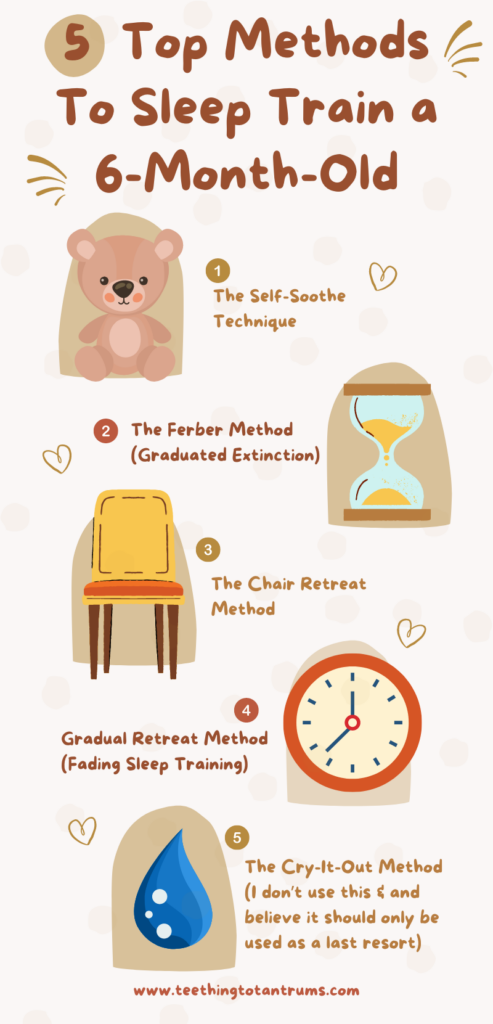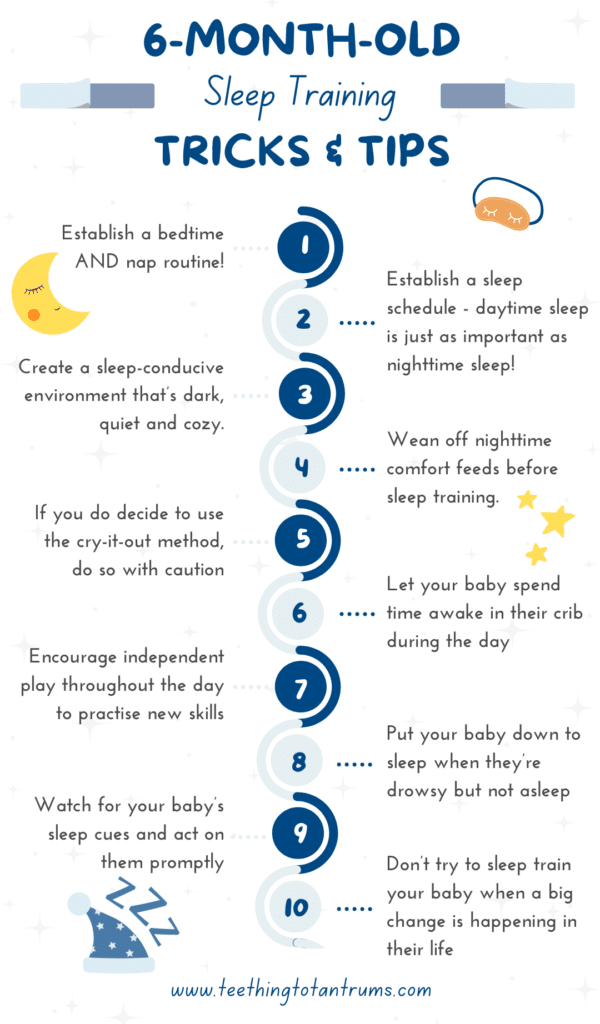Is your 6-month-old still waking multiple times a night, only sleeping when held, refusing to nap, and leaving you exhausted and desperate for a full night’s sleep? You’re not alone.
As well as establishing healthy sleep habits, sleep training a 6-month-old is one of the best ways to help your baby (and you) get the sleep you need.
In this guide, I will share with you over 40 years of childcare experience to help your baby learn to self-soothe and sleep for extended stretches. Keep reading to find out how to approach sleep training a 6-month-old in a way that works perfectly for your family.

Table of Contents
Key Takeaways
- Sleep training is teaching your baby to fall asleep independently and sleep through the night by developing healthy sleep habits and breaking negative associations. It’s typically recommended for 4 to 6-month-old babies as they start to develop self-soothing abilities.
- There are several gentle sleep training methods like the self-soothe technique, chair method, and fading sleep technique. The goal is to help baby learn to fall asleep on their own without much crying. The cry-it-out method is more intense and may not suit all families.
- To help sleep training go smoothly, establish a consistent routine, have an age-appropriate sleep schedule, create a sleep-friendly environment, and watch for and act on sleep cues promptly.
What Is Sleep Training?
Sleep training is when you teach your baby to fall asleep independently and sleep through the night. It involves developing healthy sleep habits and breaking negative sleep associations your baby may have developed. This is done by gradually teaching your baby to fall asleep on their own without the need for external soothing, such as contact napping, being rocked, or being fed to sleep.
Can You Sleep Train A 6-Month-Old?
Yes, you can sleep-train a 6-month-old.
Sleep training is typically recommended for babies around 4-6 months of age, as this is when they begin to develop the ability to self-soothe.
However, it’s important to remember that most 6-month-old babies will still be feeding at night, and more often than not, these night feeds are for comfort rather than nutrition.
Now, if your baby relies heavily on feeding to fall asleep, you will find your sleep training efforts will be more successful if you night-wean your little one first.
Trust me, trying to sleep train and night wean at the same time will be very tricky to manage. To wean your 6-month-old off nighttime feeds, read this post.
TIP: If your 6-month-old is struggling to fall asleep independently for both daytime naps and nighttime sleep, don’t try and tackle everything at once. Concentrate on bedtime and nighttime settling first, and you may find the daytime naps realign and lengthen themselves. You’d be amazed how much gets fixed when nighttime sleep is mastered!
How I Approach Sleep Training
Now, before we begin I must clarify a few things.
Firstly, I believe that sleep training is not just about implementing certain methods to get your child to sleep…
Instead, it is about approaching sleep in such a way that you teach your little one to have a healthy and balanced approach to bedtime and naps, naturally.
Secondly, I teach parents that conventional sleep training methods are only used as a last resort after having a calming evening, practicing a consistent bedtime routine, and creating a calming sleep environment.
Sleep training of any kind can be used for both naptime and nighttime sleep, but it’s important to note that sleep training during naps is a separate event from sleep training at night depending on your child’s age, developmental stage, and temperament.
On a final note, research into sleep training is often vague and inconclusive since, in most cases, the perception of what is regarded as “good sleep” and “bad sleep” in infants and toddlers is based on their parents’ perception of how much sleep they are getting and how that impacts on their mental health.
However, I still believe certain sleep training methods have their place in teaching your little one independent and healthy sleep habits.
By doing so, you will be helping your children get the restful sleep they need to meet their developmental milestones and grow into healthy, happy toddlers and preschoolers.
5 Common Sleep Training Methods + My Personal Technique
As with children of all ages, each one is different. Some 6-month-olds will naturally fall into a healthy regular sleep pattern while others will need a bit of extra help to get them on the right road to healthy sleep, not just for them… but for you too.
If you and your 6-month-old are struggling, then sleep training is a method that can help establish healthy sleep habits for your little one.
While there are many different approaches to sleep training a 6-month-old, the goal is always:
To help your baby learn to fall asleep independently and stay asleep.
Here are some of the most common sleep training methods you can consider:

- The Self-Soothe Technique: The self-soothe sleep method is a more subtle sleep training style and the one that I favor the most for babies and would always try first. It involves helping your baby to fall asleep on their own without any assistance from you by putting into place a routine that gives them the best possible chance to fall asleep independently. This means weaning off contact napping, having a consistent naptime routine, putting your baby down when they are drowsy and not fast asleep, and gradually reducing the amount of time you spend with your baby settling them.
- Ferber Method, also known as Gradual Extinction or Interval Method. This method involves gradually increasing the amount of time you leave your baby alone in their crib before going in to comfort them. The goal is to teach your baby to self-soothe and fall asleep on their own by going in to check on them at extended intervals over the training period. This method however does involve leaving your baby to cry for short periods so may not suit everyone.
- Chair Method, also known as Camping Out: This is one of my preferred methods. In this method, you settle your baby when they’re drowsy but not asleep and sit in a chair next to their crib. If your baby starts to cry, reassure them with words but do not pick them up and stay until they fall asleep. Over several nights, you move the chair further away until you’re eventually out of the room. Remember, always use your voice to soothe and do not pick your baby up.
- Gradual Retreat or Fading Sleep Technique: The fading sleep method is often a good option if your baby takes a long time to fall asleep and needs your presence to drift off. For example, you might start by holding your baby until they fall asleep, then start putting them down when they are drowsy after a short time of holding them. Next, you can start putting them down awake and then gradually moving further away from them each night until they can fall asleep on their own. If your baby doesn’t sleep after 30 minutes, remove them from the bed and try again in 15 minutes time.
- Cry-It-Out Method: The cry-it-out method involves leaving your baby to cry for a set amount of time before checking on them. The idea is that your baby will learn to self-soothe and fall asleep on their own. A more intense version of the cry-it-out method is to simply leave your baby to cry it out until they exhaust themselves and go to sleep. This method can be difficult for parents to implement, and potentially harmful to a baby’s wellbeing. Use the cry-it-out technique with great caution.
NOTE: I have never been a fan of letting babies cry it out and although this sleep training method is proven to work and not harm babies, I believe there are gentler ways to sleep train that cause far less emotional stress for both parent and baby.
Each of these methods has its pros and cons, and what works for one family may not work for another.
But remember, it’s important to be consistent with your approach and to have patience. Sleep training is not a one-night fix and the length of time it takes to sleep train can vary greatly from baby to baby.
My Preferred Sleep Training Technique For 6-Month-Old Babies
Over the years, the sleep training methods I prefer are the chair method for older children or my variation of the Ferber method which involves less crying for babies.
To use my technique, do the following:
- Settle your baby as normal after the bedtime or nap routine and put them down drowsy but not asleep.
- If your baby fusses but is not crying leave them alone for a while as many babies fuss for a while before they fall asleep.
- If they do start to cry, go in and gently put your hand on them, shush them, and maybe pat their tummy for a short time but do not pick them up.
- Once your baby is calm, leave the room.
- Repeat this as many times as necessary until they fall asleep.
- The most important thing is that you do not pick them up.
- Treat nighttime wakings in the same way.
- Over several nights you should find that your baby takes less and less time to fall asleep and you will have to make fewer visits.
- Eventually, they will fall asleep alone.
Looking to get your little one to sleep quickly and effortlessly? Check out my Bedtime and Nap Cheat Sheet and master the art of making daytime naps and bedtimes as seamless as possible.
A bedtime & nap cheat sheet so good your little one will ask you to put them to bed...
Laura Williams "This is a life saver! I'm so glad I downloaded your bedtime & nap cheat sheet. My little one actually asked me to put him to bed last night! Unbelievable! Thank you so much!"
Click Here For The FREE Cheat Sheet
Sleep Training Tips For 6-Month-Olds
It is very important to remember that sleep training can be a challenging process and it does not suit all parents… So, you should never feel pressured to sleep train your baby.
However, for many parents, it is an important step towards getting their baby to sleep through the night.
To help ensure your sleep training efforts pay off, here are my top tips (refined over 40+ years of childcare experience) to help your little one’s naps, bedtimes, and nighttime wakings go smoothly:

- Establish a bedtime AND naptime routine: This is always top of my list of things you must do. A consistent recognisable bedtime routine will help your baby understand that it’s time to sleep. And a pre-nap routine will help your baby learn that it’s time to wind down for a snooze.
- Have an established sleep schedule: You can never look at nighttime sleep in isolation. Ensuring your little one has the right amount of daytime sleep will prevent your baby from becoming overtired and impact positively on their nighttime sleep. Use an age-appropriate sleep schedule and keep a sleep diary, like this one.
- Create a sleep-conducive environment: Make sure your baby’s sleep environment is quiet, dark, and comfortable. Dress baby in appropriate clothing, use a white noise machine to block out any outside noise, and blackout blinds in the summer months to eliminate bright light.
- Gradually reduce nighttime feedings: Most babies of 6 months of age no longer need to be fed at night but it can be a difficult habit to break for some especially if they are used to being fed back to sleep. Try a dream feed at your bedtime which you gradually reduce in amount and always ensure they are getting enough breast milk/formula during the day. Once you start solid foods your baby will usually not need to be fed at night.
- Use the “cry it out” method with caution: The “cry it out” method involves letting your baby cry for a certain amount of time before going in to comfort them. While this method can be effective, it’s not suitable for all families and can be emotionally challenging for both parents and babies. I am not a fan of this method and would only ever use it as a completely last resort in extreme cases.
- Let your baby spend time awake in their crib when they are not expected to necessarily go to sleep. This will help your baby get used to being alone and feel settled within their sleep space. Installing a crib mobile is ideal for this age range.
- Encourage independent play during the day. Again, by allowing your child the opportunity to be by themselves for short periods, you will be teaching them how to self-soothe and be content in their presence. Exactly what your baby needs when they are trying to sleep.
- Put your baby down to sleep when drowsy and not fast asleep. This is easier said than done, however, it’s a technique that is incredibly effective at teaching your baby how to fall asleep independently. You may need to repeat the process a few times when you first try putting baby down when they’re not fully asleep. Also, don’t rush in to pick your baby up when they wake, you may find they resettle themselves (it is normal for babies to fuss before they fall asleep).
- Watch for your baby’s sleep cues and act on them promptly. Entering a cycle of overtiredness will be the enemy of your sleep training efforts. To avoid this, when your baby shows signs of needing to sleep, get them ready to nap. Don’t try to keep them awake until their ‘scheduled naptime’. If baby is tired, let them sleep (you can always wake them up early)
- Don’t try sleep training during periods of change such as transitioning from a crib to a cot, starting daycare, or when you’re about to travel on holiday. Your baby can only handle one big change at a time. Also, be aware of sleep regressions and always manage the sleep regression before resuming/starting sleep training. (You may need to do some sleep training once the worst of the sleep regression has passed)
6-Month-Old Sleep Schedule
Simply having a healthy age-appropriate sleep schedule can set your little one on the right road to falling asleep independently and having fewer night wakings (without the need for sleep training).
By 6 months old, your baby should be sleeping through the night and napping several times a day.
‘Sleeping through the night’ means that your baby is sleeping for 6 or more hours at night without waking to be fed.
Many 6-month-old babies will be sleeping for 6-8 hour stretches regularly, but it is important to remember that it is also perfectly normal for some babies to still wake during the night at this age too.
Here’s a sample 6-month-old sleep schedule that contains 3 daytime naps:

When To Consult A Pediatrician
If you have tried sleep training your 6-month-old, but there is no progress happening, you may wish to rule out any underlying condition that is impacting the process.
A pediatrician can help rule out any underlying medical conditions that may be affecting your baby’s sleep.
If your baby is experiencing stress or sleep deprivation, a pediatrician can also guide sleep tips and techniques to help your baby get regular sleep again. They may also recommend a pediatric sleep doctor to help diagnose and treat any sleep disorders.
Frequently Asked Questions About Sleep Training A 6-Month-Old
Looking for more information about sleep training a 6-month-old? Here are the most commonly asked questions about helping little ones sleep, answered just for you.
Q: How many nights does it take to sleep train a 6-month-old baby?
A: The length of time it takes to sleep train a 6-month-old baby can vary between a few nights and a few weeks. Consistency is key, and it’s important to remember that every baby is different so a technique that works for one baby, may not work for another.
Q: What are some gentle sleep training methods for a 6-month-old?
A: Several gentle sleep training methods can be used for a 6-month-old, such as the gradual retreat method and the chair method. However, the most important part of sleep training is to find a method that works best for your baby and family.
Q: Is it possible to sleep train a 6-month-old without crying it out?
A: Yes, it is possible to sleep train a 6-month-old without crying it out. Gentle sleep training methods, such as the pick-up-put-down and the chair method, can be highly effective ways to help your baby fall asleep independently without resorting to crying it out.
Q: What are the benefits of sleep training a 6-month-old?
A: Sleep training a 6-month-old can lead to better sleep for both the baby and the parents which means your daytime routines are probably going to go a lot better too. It can also help establish healthy sleep habits that last a lifetime and promote restorative sleep.
Q: How do I teach my 6-month-old to fall asleep without rocking?
A: One way to teach a 6-month-old to fall asleep without rocking is to establish a consistent bedtime routine. This can include a bath, a story, and a lullaby. When putting your baby down, gradually reduce the amount of time you rock them and put your baby down when they are drowsy until your baby can fall asleep without it. For example, if you normally rock for 20 minutes, rock for 15 minutes tonight. Then each successive night, reduce the amount of time you rock baby by 2-5 minutes.
Q: Why does my 6-month-old wake up frequently during the night?
A: There are several reasons why a 6-month-old may wake up frequently during the night, such as hunger, discomfort, habit, need for comfort, or inability to self-settle. It’s important to rule out any underlying medical issues and establish healthy sleep habits to help reduce nighttime wakings.
Q: How long should I let my 6-month-old cry it out during sleep training?
A: The length of time you let your 6-month-old cry it out during sleep training can vary. If you use the Ferber method, you start with short intervals of crying and gradually increase the time you leave your baby to cry it out. While I am not a fan of the crying-out method, especially at this age, you should follow your instincts and find a method that works best for your baby and family.
Need More Parenting Help?
- Download our FREE Bedtime & Nap Sleep Cheat Sheet. It’s a free, easy-to-use and proven formula designed for parents of 0-5 year olds to master the art of consistently undisturbed and restful sleep without the yelling, nagging or exhausting long-winded evenings.
- Check out our Parenting Toolbox. You’ll get access to expertly-chosen products that you can guarantee are the best for your little one and your wallet.
- Are you looking for personalized guidance to navigate the challenges of parenting? I offer 1-on-1 consultations to bring you tailored strategies and actionable advice to help support your child's growth and well-being with confidence.

A bedtime & nap cheat sheet so good your little one will ask you to put them to bed...
Laura Williams "This is a life saver! I'm so glad I downloaded your bedtime & nap cheat sheet. My little one actually asked me to put him to bed last night! Unbelievable! Thank you so much!"
Click Here For The FREE Cheat Sheet


